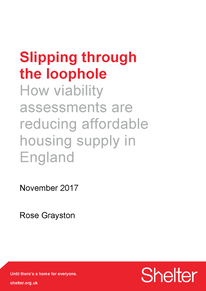|
Unviable focuses on the ways in which affordable housing has been undermined in the city of Oxford over the past decade in large part due to a new tool in the arsenal of housing developers: the Financial Viability Assessment (FVA).
Since a loophole was introduced in 2012, these reports have been used to demonstrate 'competitive return'. Developers argue that there must be a set level of profit left over after all the costs of delivering a scheme, usually 17.5-20% of the total sales value. If local planning obligations put an unreasonable burden on the profit-expectation of developers then viability assessments can be used to argue for a reduction in things like affordable housing. In July 2018 rules on the use of viability assessments were tightened but as we show in this website, they might not yet be tight enough. |
affordable homes
have been lost through the viability process in Oxford since 2012
|
Every effort has been made to ensure the accuracy of information on this website, however we are group of volunteers and this is a highly-complex field. If you believe an element of this website is inaccurate please contact us and we will do our best to amend it.
Issues this website covers
FAQwhat is affordable housing?
The current national definition of Affordable Housing is:
"housing for sale or rent, for those whose needs are not met by the market (including housing that provides a subsidised route to home ownership and/or is for essential local workers)" National Planning Policy Framework (Feb19) It is then usually broken down between Social Rented Housing and Intermediate Housing. There are now 79 per cent fewer social homes created each year compared to the first half of the 1990s (Shelter 2018). Since 2011 there has been no requirement to deliver social housing unless it is in a Local Authority's 'Local Plan' and there had been limited public grant to deliver social housing until June 2018. In 1994 a high court judge upheld the decision of QC Roy Vandermeer that affordable housing need is a material consideration in a planning decision. Since 1994 however the definition of affordable housing has shifted away from incomes and need to being related to whether a household can access the housing market. Many people now question what is meant by affordable housing if it has little relationship to whether someone can afford it. what does national legislation say about viability?
The government's approach to viability is outlined in Paragraph 57 of the National Planning Policy Framework 2019.
Where up-to-date policies have set out the contributions expected from development, planning applications that comply with them should be assumed to be viable. It is up to the applicant to demonstrate whether particular circumstances justify the need for a viability assessment at the application stage. The weight to be given to a viability assessment is a matter for the decision maker, having regard to all the circumstances in the case, including whether the plan and the viability evidence underpinning it is up to date, and any change in site circumstances since the plan was brought into force. All viability assessments, including any undertaken at the plan-making stage, should reflect the recommended approach in national planning guidance, including standardised inputs, and should be made publicly available. The Government has also created a Planning Practice Guide to Viability (September 2019) which sets out some of the expected assumptions (link). Essentially viability is now set when Local Planning Authorities (LPAs) are allocating sites in their local plan and it as at the discretion of the LPA as to how much weight to give a Financial Viability Assessment (FVA). Before July 2018 developers could use an FVA to reduce the number of affordable homes and LPAs had limited powers to fight this. Contrary to common-belief, the viability loophole in Para 57 of the NPPF 2018 DID NOT CLOSE although it is now up to the applicant to prove the need for a viability appraisal. The draft NPPF asserted that the Local Plan was deemed viable removing the ability of developers to use FVAs however this did not make it into the final version. The Local Authority ‘having regard to all the circumstances in the case’ makes us tracking this stuff as important as ever. why is this different for charities?
The effect of Charitable Landowners on housing schemes
WHAT IS THE APPROACH OF COUNCILS IN AND AROUND OXFORD?
Oxford City Council require 50% of any scheme of 10 homes and above to be affordable housing - of that 50%, the social housing should make up 80%. So on a scheme of 100 homes, 50 would be market, 10 would be intermediate and 40 homes would be for social rent. If a developer claims that their scheme is not viable Oxford City Council has a 'cascade' system as set out in their Affordable Housing and Planning Obligations SPD (link). Negotiations, called an 'open book' approach, to reduce the level of affordable housing start from the policy compliant 50% and iteratively taking out intermediate homes and then social homes but this cannot drop below 40%. Before the 2018 legislation we think the council had been only requesting a Financial Value Assessment when a scheme goes below their cascade to 40% social rent - for example Oxford didn't pop up in Shelter's 2018 research window (2015-16) on viability loopholes (linked to the right) despite the Beaumont Gate decision coming that year |
Further reading2018 - Shelter
We closed the viability loophole (Shelter) 2017 - Shelter Report: Slipping through the loophole: How viability assessments are reducing affordable housing supply in England (Shelter) 2017 - DCLG Planning for the right homes in the right places: consultation proposals (DCLG) |
How this website works
Each page will tell you key details about the scheme and then break down the mix of homes by tenure, comparing the amount required by Oxford City Council planning policy and the amount promised or delivered by the scheme.
Contact Us
|
We are a group of local housing professionals with a concern for the effects of a lack of housing affordability in Oxford. The key mechanism society currently has for delivering affordable homes is through Planning Obligations delivered through Section 106 agreements. We want to draw attention to how this mechanism is not delivering the homes to meet current need and is limiting the ability for the current and future citizens to thrive here in the City of Oxford.
|
|


